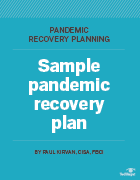
Guido Vrola - Fotolia
It's time to update your pandemic disaster recovery plan
Your DR plan may be unprepared for a pandemic, and while mid-pandemic is not the ideal time to be discovering issues, you should use this time to make changes.
Having a disaster recovery plan in place implies that a business believes there will come a time when operations will be disrupted, and it will be necessary to respond and run operations in some lessened or alternate capacity. When you think about the last few months, it sounds all too familiar. The shift to enabling remote work has been a DR scenario that few of us ever planned for or anticipated.
The changes in the way your business operates during the COVID-19 outbreak dictate what your pandemic disaster recovery plan needs to include for both this and the next potential pandemic.
You probably have a lot on your plate, but we are living and working during a pandemic and, as such, it's necessary to think about changes you need to make for your recovery plan to be pandemic-ready.
Updating your current plan
There are plenty of lessons you've already learned adapting to working in a pandemic, but let's go over a few areas where current DR strategies and plans need to change. If you haven't already, be sure that your organization does the following:
- Capitalize on this time to learn. Most of the time, the act of disaster recovery planning is an exercise in academics, concepts and theoretical scenarios. In this case, you're living through a scenario you likely never envisioned and now have tons of anecdotal detail from organizations around the world that are going through the same thing. The opportunity to understand not just the effect the pandemic has had on your organization, but the problems others have experienced is highly beneficial. The issues other businesses face in this pandemic could affect you during a new crisis.
- Add pandemic to the plan. One thing this pandemic has taught us about DR is that it's possible to have a disaster that affects how and not just whether the business runs. So, a pandemic disaster recovery plan requires a new focus, one where we consider changes necessary to facilitate the way the business will operate. This may affect users, endpoints, applications, servers and data. The response to a pandemic will look drastically different than the response to an outage of an entire data center. Even another pandemic may spread differently and require different distancing measures. You must formulate a plan for this specific scenario and build something completely new.
- Start with connectivity. Usually DR plans center around identifying workloads, applications and data that need to be made available. With a pandemic recovery plan that requires employees to work remotely for indefinite periods of time, the issue is more about shifting workforces and their ability to connect to corporate resources. You've already learned from the last few months the good and bad of allowing employees to use their personal devices, their insecure home networks and connections to the corporate network -- whether remotely accessing their work desktop, VPN or virtual desktops. Take the best outcomes you've experienced and work backward to develop a DR plan that facilitates fast and predictable recovery of operations should another pandemic occur.
- Consider the effect on corporate resources. In a perfect world, remote workforces just connect to the corporate network -- via VPN, for example -- and work. But you may also need to move internal applications, systems and data to the cloud to facilitate normal business operations. In some cases, the decision might be to shift internal workloads to the cloud permanently. For those organizations that are going to keep the corporate network as is, the need to potentially move some of these resources to cloud-based infrastructure should be considered and added to the plan.
Assuming you've put out all the operational fires and are running at some level of operational stability, it's time to begin thinking about the future. Consider that this could happen again and start planning your disaster recovery for the next pandemic.
By using the context you have of living through a pandemic and your existing DR plan as the starting point, you should be able to quickly ascertain where your pandemic disaster recovery plan falls short and what needs to change. Then you can begin documenting the process of recovering from another pandemic that we all hope never happens.

 Download our free
Download our free





